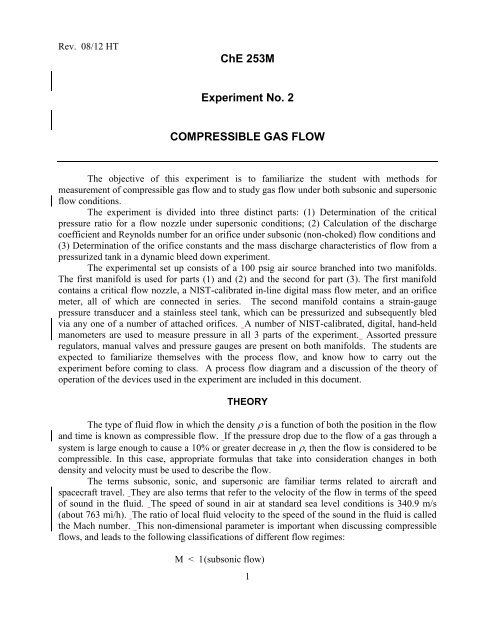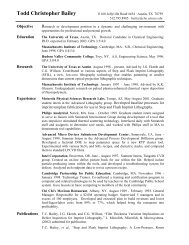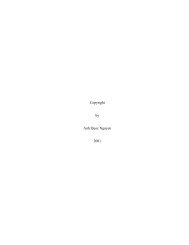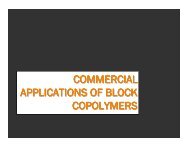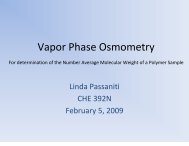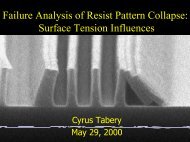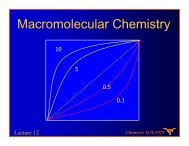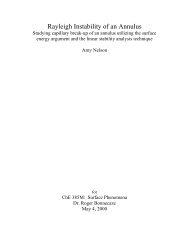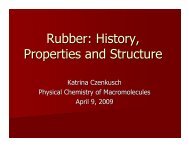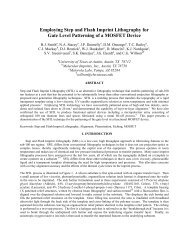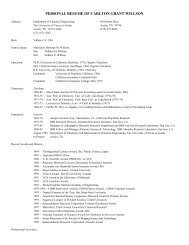ChE 253M Experiment No. 2 COMPRESSIBLE GAS FLOW
ChE 253M Experiment No. 2 COMPRESSIBLE GAS FLOW
ChE 253M Experiment No. 2 COMPRESSIBLE GAS FLOW
You also want an ePaper? Increase the reach of your titles
YUMPU automatically turns print PDFs into web optimized ePapers that Google loves.
Rev. 08/12 HT<br />
<strong>ChE</strong> <strong>253M</strong><br />
<strong>Experiment</strong> <strong>No</strong>. 2<br />
<strong>COMPRESSIBLE</strong> <strong>GAS</strong> <strong>FLOW</strong><br />
The objective of this experiment is to familiarize the student with methods for<br />
measurement of compressible gas flow and to study gas flow under both subsonic and supersonic<br />
flow conditions.<br />
The experiment is divided into three distinct parts: (1) Determination of the critical<br />
pressure ratio for a flow nozzle under supersonic conditions; (2) Calculation of the discharge<br />
coefficient and Reynolds number for an orifice under subsonic (non-choked) flow conditions and<br />
(3) Determination of the orifice constants and the mass discharge characteristics of flow from a<br />
pressurized tank in a dynamic bleed down experiment.<br />
The experimental set up consists of a 100 psig air source branched into two manifolds.<br />
The first manifold is used for parts (1) and (2) and the second for part (3). The first manifold<br />
contains a critical flow nozzle, a NIST-calibrated in-line digital mass flow meter, and an orifice<br />
meter, all of which are connected in series. The second manifold contains a strain-gauge<br />
pressure transducer and a stainless steel tank, which can be pressurized and subsequently bled<br />
via any one of a number of attached orifices. A number of NIST-calibrated, digital, hand-held<br />
manometers are used to measure pressure in all 3 parts of the experiment. Assorted pressure<br />
regulators, manual valves and pressure gauges are present on both manifolds. The students are<br />
expected to familiarize themselves with the process flow, and know how to carry out the<br />
experiment before coming to class. A process flow diagram and a discussion of the theory of<br />
operation of the devices used in the experiment are included in this document.<br />
THEORY<br />
The type of fluid flow in which the density is a function of both the position in the flow<br />
and time is known as compressible flow. If the pressure drop due to the flow of a gas through a<br />
system is large enough to cause a 10% or greater decrease in , then the flow is considered to be<br />
compressible. In this case, appropriate formulas that take into consideration changes in both<br />
density and velocity must be used to describe the flow.<br />
The terms subsonic, sonic, and supersonic are familiar terms related to aircraft and<br />
spacecraft travel. They are also terms that refer to the velocity of the flow in terms of the speed<br />
of sound in the fluid. The speed of sound in air at standard sea level conditions is 340.9 m/s<br />
(about 763 mi/h). The ratio of local fluid velocity to the speed of the sound in the fluid is called<br />
the Mach number. This non-dimensional parameter is important when discussing compressible<br />
flows, and leads to the following classifications of different flow regimes:<br />
M < 1 (subsonic flow)<br />
1
M = 1 (sonic flow)<br />
M > 1 (supersonic flow)<br />
Interestingly enough, the Mach number has some additional physical meaning. For a<br />
“calorically perfect” gas, the square of the Mach number is proportional to the ratio of kinetic to<br />
internal energy. Therefore, it is a measure of the directed motion of the gas compared to the<br />
random thermal motion of the molecules.<br />
What is perceived as the sense of sound by the brain is in actuality the effect of pressure<br />
fluctuations acting on the ear. These weak vibrations travel as pressure waves, alternate<br />
expansions and contractions, through the surrounding fluid. The velocity of their propagation is<br />
the speed of sound, which can be determined by applying the laws of conservation of mass and<br />
linear momentum across a pressure wave front traveling through a stationary fluid. The process<br />
inside the sound wave is assumed to be isentropic; there are no viscous forces acting on the fluid<br />
and no heat transfer to or from it. This assumption is reasonable since the wave front has an<br />
infinitesimal length and there is not enough time for heat transfer to occur. The flow is therefore<br />
considered to be reversible and adiabatic.<br />
Compressible Flow through Orifice and Venturi Meters<br />
Two types of devices are treated together: orifice and venturi meters. They are both<br />
obstruction meters, and based on the same fundamental principle. The device consists of an<br />
obstacle placed in the path of the flowing fluid that causes localized changes in velocity, and<br />
consequently, in pressure. At the point of maximum restriction, the velocity will be the<br />
maximum and the pressure minimum. A part of this pressure loss is recovered downstream of<br />
the obstruction.<br />
“1” “2”<br />
Flow<br />
Figure 1: Compressible Flow through an orifice<br />
The basic equation for calculating the pressure drop through an orifice or venturi is the Bernoulli<br />
equation,<br />
2<br />
V<br />
gh<br />
P = constant (1)<br />
2g<br />
c<br />
g c<br />
where P is pressure, ρ is fluid density, V is fluid velocity, g is acceleration of gravity, h is height,<br />
and g c is a conversion factor for English units. If subscript “1” refers to the upstream conditions<br />
and subscript “2” to the downstream conditions at the point of pressure measurement, then<br />
2
assuming negligible change in temperature and no change in elevation (flow in a horizontal pipe)<br />
the Bernoulli equation simplifies to,<br />
V<br />
V<br />
P (2)<br />
2 2<br />
1 1 2 2<br />
1<br />
P2<br />
2gc<br />
2gc<br />
For an incompressible fluid such as a liquid, can be assumed to be constant (for a gas is not<br />
constant). If Q is the volumetric flow rate of the liquid, Q = A 1 V 1 = A 2 V 2 , where A 1 and A 2<br />
are the cross-sectional areas at points “1” and “2” where the pressures are measured. Thus we<br />
can write:<br />
2 2<br />
<br />
1<br />
Q <br />
1<br />
<br />
1<br />
Q <br />
1<br />
P1 P2<br />
<br />
2g A 2g A<br />
For a liquid, solving for Q<br />
1<br />
the volumetric flow rate,<br />
c 2 c 1 <br />
(3)<br />
Q<br />
A<br />
2 g ( P P ) / <br />
c 1 2 1<br />
1 2 2<br />
1 ( A2 A1)<br />
(4)<br />
However, a gas is compressible so for gases an expansion factor (Y) must be added to the above<br />
equation to compensate for changes in density across the restriction. Also, to account for<br />
pressure losses in the device, a discharge coefficient C d must be introduced. Hence the final<br />
form of the equation governing the volumetric flow rate of a gas through an orifice is :<br />
or<br />
Q<br />
C Y A<br />
2 g ( P P )<br />
c 1 2<br />
1 d 2 4<br />
1(1 )<br />
1 2 c 1 2 1<br />
(5a)<br />
Q CY A 2 g ( P P ) <br />
(5b)<br />
4<br />
where = d 2 / d 1 is the ratio of the orifice diameter to the pipe diameter and C C d<br />
1<br />
.<br />
Multiplying by the density upstream of the orifice, we obtain the mass flow rate, w, of the fluid<br />
at any point,<br />
w Q CY A gc<br />
( P )<br />
(6)<br />
1 1<br />
2<br />
2<br />
1 1<br />
P2<br />
For the flow of liquid, the expansion factor, Y is unity and for gases Y can be calculated from<br />
<br />
1<br />
<br />
4<br />
2 1<br />
r <br />
1<br />
<br />
Y r <br />
<br />
<br />
(7)<br />
<br />
4<br />
1<br />
1<br />
r 1<br />
r<br />
2 <br />
<br />
<br />
3
where r = P 2 / P 1 and = c p / c v is the specific heat ratio, equal to = 1.4 for air. For values of <br />
4<br />
less than 0.25, aproaches zero and the last bracketed term in the above equation approaches 1<br />
so that the equation simplifies to<br />
Y<br />
<br />
r<br />
2 <br />
<br />
1<br />
<br />
1<br />
r<br />
<br />
<br />
1<br />
1<br />
r<br />
<br />
<br />
<br />
(8)<br />
Values of Y as a function of r, and can be calculated either directly from equations 7 or 8 or<br />
can be read from a graph that readily displays computed values of Y as a function of these<br />
parameters (see appendix). Finally, substituting equation 8 into the mass flow rate equation 6<br />
and simplifying using the ideal gas law yields the general equation for subsonic (non-choked)<br />
flow of an ideal gas through an orifice<br />
w C P A<br />
1<br />
2<br />
2gcM<br />
RT<br />
1<br />
<br />
<br />
<br />
<br />
P <br />
2<br />
<br />
<br />
<br />
<br />
1<br />
<br />
P1<br />
<br />
2 <br />
P2<br />
<br />
<br />
P1<br />
<br />
<br />
<br />
<br />
1<br />
<br />
<br />
<br />
<br />
<br />
(9)<br />
Critical Flow <strong>No</strong>zzle – Choked Flow<br />
Consider the case where a compressible fluid is expanded from a given pressure “1” to a<br />
lower downstream pressure “2” in a carefully-machined nozzle of the sort depicted in Figure 1.<br />
As the downstream pressure, or back pressure, is lowered, the mass flow rate and the fluid<br />
velocity increase until the velocity in the throat of the nozzle becomes sonic. The value of r = P 2<br />
/ P 1 at which the speed of sound is reached is called the critical pressure ratio r c and depends<br />
only on (ratio of specific heat capacities) and (ratio of nozzle to pipe diameters).<br />
For ≤ this is given by<br />
1<br />
2 <br />
r<br />
c<br />
= 0.528 for air ( (10)<br />
1<br />
As long as the flow in the throat is sonic, the mass flow rate through the nozzle is<br />
constant for a given value of upstream pressure, and the flow is said to be choked. Any further<br />
lowering of the downstream pressure does not increase the throat velocity above sonic.<br />
However, if the downstream pressure is raised above this critical value, the velocity at the throat<br />
goes subsonic and choked flow conditions no longer exist (Figure 2).<br />
4
Mass<br />
Flow<br />
Rate<br />
Air<br />
Velocity<br />
Sonic Velocity<br />
1127 ft/s @ 68 ºF<br />
P 1 = Constant<br />
1<br />
2 <br />
r c<br />
<br />
1<br />
0.528 for air<br />
1<br />
P 2 / P 1<br />
0<br />
Figure 2: For a fixed inlet pressure P 1 , the air velocity and mass flow rate are limited<br />
(choked) below the critical pressure ratio.<br />
During choked or critical flow conditions, the flow rate can be increased only by<br />
increasing the upstream pressure. When the pressure ratio r reaches the critical value r c of<br />
equation 10, then the mass flow rate for choked flow in equation 9 reduces to:<br />
5<br />
( 1)<br />
( 1)<br />
gc M 2 <br />
w C A P . (11)<br />
RT1 1<br />
Since C, A, g c , , M, R are constant for a given nozzle and gas, they can be combined to result<br />
the following simplified relation:<br />
w K P<br />
,<br />
T<br />
gcM<br />
2 <br />
K CA<br />
<br />
<br />
R 1<br />
<br />
1) /( 1)<br />
<br />
1/ 2<br />
It turns out that K (and hence C) is a weak function of P (a plot of K versus P for the<br />
critical flow nozzle used in this experiment is attached in the appendix). Therefore, at choked<br />
flow the only measurements required to determine the flow rate through the critical flow nozzle<br />
are the upstream pressure and temperature. Finally, note than when a downstream diffuser<br />
(divergent) recovery section is added to the flow nozzle (better known as critical flow venturi<br />
nozzle), the value for the critical pressure ratio r c is no longer the theoretical value given in<br />
equation 10, but ranges from 0.80 to 0.95 depending on the design. (<strong>No</strong>te: the flow nozzle in this<br />
experiment does have such a diffuser recovery section).<br />
List of Variables and Constants<br />
Q 1 = upstream volumetric flow rate, ft³/s<br />
w = mass flow rate at any point, lb m /s<br />
C d = coefficient of discharge, dimensionless<br />
C = orifice flow coefficient, dimensionless<br />
Y = expansion factor, dimensionless<br />
<br />
<br />
<br />
(12)
A 1 = cross-sectional area of the pipe, ft²<br />
A 2 = cross-sectional area of the orifice hole, ft²<br />
d 1 = diameter of the pipe, ft<br />
d 2 = diameter of the orifice hole, ft<br />
β = ratio of orifice hole diameter to pipe diameter, dimensionless<br />
V 1 = upstream fluid velocity, ft/s<br />
V 2 = fluid velocity through the orifice hole, ft/s<br />
P 1 = fluid upstream absolute pressure, lb f /ft 2<br />
P 2 = fluid downstream absolute pressure, lb f /ft 2<br />
ρ 1 = upstream fluid density, lb m /ft³<br />
R = Universal Gas constant, 1545 ft lb f / lbmole °R<br />
g c = dimensional constant, 32.2 lb m ft/sec 2 lb f<br />
Dynamic Pressure Bleed Down Rate Measurement<br />
An important application of choked flow is in calculating accidental release flow rates<br />
from pressurized gas systems. Every pressure tank in a chemical plant is connected to a flare<br />
system through a pressure relief valve. This is to ensure that if a pressure vessel becomes overpressurized,<br />
the tank can relieve itself without rupturing. In most cases the flow from the tank<br />
passes through a restriction where the flow is sonic and it is the diameter of the restriction which<br />
determines how fast gas can escape. Gas flow is sonic if the upstream absolute pressure is<br />
approximately twice the downstream pressure (approx. 28 psia when released to the atmosphere).<br />
The experimental tank, rated at 1,800 psig, has an internal volume of 10.3 L. The air is<br />
released through orifices having diameters of 0.030, 0.040, and 0.055 inches plus an orifice of<br />
unknown diameter to be determined experimentally. The rate of pressure fall-off through these<br />
three orifices is measured with a pressure transducer that is connected to a computer-based data<br />
acquisition system. As we have seen earlier, for a critical flow orifice<br />
( 1)<br />
( 1)<br />
gc M 2 <br />
w C A P <br />
(11)<br />
RT1 1<br />
We can simplify this equation in a manner similar to what we did in equation 12. If air is<br />
discharged at constant upstream temperature T 1 then the equation can be simplified to<br />
w <br />
dm<br />
Kd<br />
dt<br />
2<br />
P<br />
(13)<br />
so that the mass flow rate is only a function of the pressure P and orifice diameter d, and all other<br />
variables are included in the orifice constant K. Since air is an ideal gas,<br />
PV<br />
m<br />
nRT RT so that<br />
M<br />
PVM<br />
m (14)<br />
RT<br />
6
and differentiation yields<br />
dm VM dP . (15)<br />
dt RT dt<br />
Substituting back into (13),<br />
VM dP 2<br />
Kd P<br />
RT dt<br />
dP<br />
P<br />
<br />
2<br />
Kd RT<br />
VM<br />
dt<br />
P<br />
<br />
P0<br />
dP<br />
P<br />
t<br />
t0<br />
2<br />
Kd RT<br />
VM<br />
dt<br />
2<br />
Kd RT<br />
ln P t + constant<br />
VM<br />
2<br />
ln P K'<br />
d t + constant (16)<br />
In this part of the experiment, you will use Equation 16 to determine K' based on your<br />
experimental data for the three orifices provided and then use this value to determine the<br />
diameter of an unknown orifice.<br />
Finally, if we assume that our process is adiabatic and frictionless, then the discharge of the gas<br />
through the orifice is an isentropic expansion of an ideal gas for which<br />
<br />
P<br />
constant (17)<br />
For a tank with constant volume, the density is proportional to the mass of the gas inside the<br />
tank and equation 17 can be re-arranged to yield a simple relation between the pressure in the<br />
tank and the mass fraction f m m0<br />
of fluid remaining,<br />
P P0<br />
<br />
f<br />
(18)<br />
7
Pressure And Flow Measuring Devices Used in this <strong>Experiment</strong><br />
Bourdon Gauge<br />
This very common gauge operates on the principle that the deflection or deformation in a<br />
spiral metal tube can be related to the balance of pressure and elastic forces. The Bourdon tube<br />
is initially coiled in a "C" shaped arc. The tube is sealed at one end and open to the pressure to<br />
be measured at the other. As the pressure increases, the tube deforms, and the motion is<br />
transmitted to a dial indicator by means of a mechanical linkage. <strong>No</strong>te that in this experiment, the<br />
bourdon gauge is used only as a visual indicator – the NIST-calibrated Digital Handheld<br />
Manometer described below will be used for recording pressure data to be used in your<br />
calculations.<br />
Schaevitz Strain Gauge Transducer<br />
Whereas the bourdon gauge discussed above produces a direct measurement of the<br />
applied pressure via its mechanical linkage and dial indicator, the Schaevitz strain gauge outputs<br />
a voltage signal that is proportional to the applied pressure. This is because the Schaevitz strain<br />
gauge is a transducer. Broadly defined, a transducer is a device, usually electrical, electronic, or<br />
electro-mechanical, that senses or converts a signal from one form to another. In our case, the<br />
strain gauge converts a physical signal (pressure) into an analog signal (voltage). The most<br />
common type of strain gauge consists of an insulating flexible backing which supports a metallic<br />
foil pattern. As pressure is applied, the foil is deformed, causing its electrical resistance to<br />
change. This resistance change, usually measured using a Wheatstone bridge, is related to the<br />
applied strain. Another popular class of strain gauge transducers employs a piezoelectric-type<br />
element. Application of pressure causes it to deform and generate a small potential that is<br />
proportional to the applied pressure.<br />
Differential Manometer<br />
This instrument consists of a simple U-tube about half full of a liquid (in this case, water)<br />
of known density. The two ends of the tube can be connected to the two pressure sources. The<br />
height difference in the liquid column is then proportional to the pressure differential.<br />
Digital Handheld Manometer (NIST Calibrated)<br />
Just like the Schaevitz gauge, this is also a strain gauge transducer but here the strain element is<br />
not a metallic foil but a semiconductor, usually a piece of crystal silicon. Application of pressure<br />
on semiconductor materials such as silicon and germanium causes a proportional change in the<br />
resistance of these materials, a phenomenon known as the piezoresistive effect.<br />
Digital Mass Flow Meter (NIST Calibrated)<br />
The stream of gas entering the Mass Flow transducer is split by shunting a small portion of the<br />
flow through a capillary stainless steel sensor tube. The remainder of the gas flows through the<br />
primary flow conduit. According to principles of fluid dynamics the flow rates of a gas in the<br />
two laminar flow conduits are proportional to one another. Heat flux is introduced at two<br />
sections of the sensor tube by means of precision wound heater sensor coils. As the gas flows<br />
inside the sensor tube, heat is carried by the gas stream from the upstream coil to the downstream<br />
coil windings. The resultant temperature-dependent resistance differential is detected by the<br />
electronic control circuit and the measured gradient at the sensor windings is linearly<br />
proportional to the mass flow rate taking place.<br />
8
PROCEDURE<br />
In addition to the various gauges listed above, the manifold assembly for parts (1) and (2)<br />
includes a main ball valve that supplies air pressure and three gate valves. See the Appendix of<br />
this document for a detailed schematic. In Manifold A, these valves regulate the pressures in the<br />
various parts of the system as follows :<br />
Valve 1A (Pressure Regulator) is located upstream of the critical flow nozzle and<br />
regulates the pressure (P 1 ) upstream to the nozzle. Under choked flow conditions, the<br />
mass flow rate through the system is a function of this pressure and temperature only.<br />
Valve 2A is located downstream of of the critical flow nozzle next to a turbine flow<br />
meter that is not used in this experiment. It regulates the back pressure (P 2 ) of the<br />
nozzle. To ensure choked flow, P2 must be kept below its critical value.<br />
Valve 3A is located downstream of a rotameter not used in this experiment. This valve<br />
should stay open throughout the experiment.<br />
1. Determination Of The Critical Pressure Ratio For Choked Flow And Calibration<br />
Of Critical Flow <strong>No</strong>zzle (CFN):<br />
1) Record the atmospheric temperature and pressure. The Teaching Assitant will demonstrate<br />
the use of the barometer used to measure ambient pressure.<br />
2) Set P 1 at 90 psig by adjusting valve 1A (the pressure regulator). Open valves 2A and 3A<br />
completely.<br />
3) Allow 1-2 minutes for the digital mass flow meter to stabilize and record this Q DFM value .<br />
Also record the temperature (T 1 ) upstream to the nozzle.<br />
4) Increase the backpressure (P 2 ) to 10 psig by setting valve 2A appropriately and record the<br />
new flowrate (again, allow enough time for the reading to stablize).<br />
5) Continue to raise the backpressure (P 2 ) in increments of 5 psig and note the point at which<br />
the digital mass flow meter reading begins to change. The corresponding value of P 2 is the<br />
critical backpressure for the given value of P 1 . When P 2 is greater than this critical value,<br />
the flow through the throat is no longer sonic and decreases as P 2 increases.<br />
6) Determine the critical backpressure for the CFN at an upstream pressure (P 1 ) of 70, 50 and<br />
30 psig and close valve 1A when you are finished.<br />
2. Discharge Coefficient For The Orifice Meter<br />
Open valves 2A and 3A completely. Make sure the manometer is about half-full of water and<br />
open the turn valves on the sides of the orifice to allow the pressure to reach the differential<br />
manometer. Set P 1 (by adjusting valve 1A) such that the manometer P is 2 inches H 2 O.<br />
9
Record this P 1 , T 1 and flow rate Q DFM for this setting. Repeat for P = 4 and 6 inches H 2 O.<br />
When you are finished, make sure you close the turn valves on the sides of the orifice and the<br />
main ball valve that supplies air pressure to the manifold.<br />
3. Dynamic Pressure Bleed Down Rate Measurement<br />
NOTE: You can save your data on a USB memory stick or in your UT webspace account<br />
The manifold assembly B for this part consists of the main valve that supplies air pressure, plus:<br />
<br />
<br />
<br />
<br />
<br />
Valve 1B is a pressure regulator that controls the air pressure into the system<br />
Valve 2B is a manual ball valve that controls the air pressure to the digital manometer<br />
Valve 3B is a manual ball valve upstream of the Schaevitz Strain Gauge transducer<br />
Valve 4B is a manual ball valve downstream of Schaevitz Strain Gauge transducer<br />
Valve 5B is a manual gate valve upstream of the tank. Leave this valve open at all times.<br />
(i) Calibration of the Schaevitz Strain Gauge transducer<br />
First you need to calibrate the Schaevitz Strain Gauge transducer (output in millivolts) against<br />
the NIST-calibrated handheld digital manometer (output in psig).<br />
1. Make sure the 10V DC power supply located behind the computer (used to power the<br />
Schaevitz Strain Gauge transducer) is switched on and then start the Dell computer. Login as<br />
“Fun Lab” and double click the icon on the desktop labeled “Tank Bleeddown.vi”. This is a<br />
LabView based program written specifically to control the data acquisition process, and<br />
continuously displays the voltage output from the Schaevitz Strain Gauge transducer.<br />
2. Verify that Valves 2B and 3B are open and Valve 4B is closed (NO air going to the tank).<br />
Open the main manual ball valve that supplies air pressure to the manifold, and adjust the<br />
pressure regulator (Valve 1) until the pressure reading on the NIST-calibrated handheld<br />
digital manometer is ~10 psig. Read the corresponding voltage output from the Schaevitz<br />
Strain Gauge transducer via the LabView program on the computer.<br />
3. Repeat the process in steps of 10 psig until you reach a final pressure of 90 psig. You now<br />
have 9 points of Pressure vs. mV to obtain a calibration curve.<br />
(ii) Bleed Down <strong>Experiment</strong><br />
4. You are now ready to fill the tank with air. First make sure all the orifices attached to the<br />
tank are closed and close valve 2B (digital manometer off-line). Increase the line pressure to<br />
~95 psig, and open valve 4B to fill the tank. You should hear the air filling the tank. When<br />
it stops, close valve 3 so that air does not refill the tank while it is discharging.<br />
5. On the computer you should see the voltage reading on the graph display increase as the tank<br />
fills up and then plateaus when the pressure has stabilized. You may also change the rate at<br />
which data are collected via the “Data Collection Rate” control. Typically, you should select<br />
a slow data collection rate for small orifices and a fast data collection rate for the larger<br />
10
orifices. Once you have selected a data collection rate, click the “Save Data” button and<br />
enter a filename for the bleed down trial. The voltage data is saved in an EXCEL<br />
spreadsheet file in the directory C:\DATA\.<br />
6. The transducer voltage should show up immediately and begin plotting on the screen. Keep<br />
in mind that the orifice bleed down coefficient describes the pressure over time only while<br />
the orifice is open. Data collected while the orifice is closed is useless for such an analysis.<br />
Therefore you should disregard data that is collected after the orifice is closed.<br />
7. Wait for a few seconds until you save a baseline pressure reading from the tank and then<br />
open one of the orifice valves (you will be doing 3 runs - it doesn’t matter which one you do<br />
first). Then, allow the pressure to drop to approximately 30 psig by monitoring the pressure<br />
reading on the small gauge at the side of the tank. When the pressure has reached close to 30<br />
psig, close the orifice valve and on the computer click the button labeled “Writing to data file<br />
– click again to stop writing.” The program resets and is now ready for a new acquisition –<br />
you do not have to press the red stop button on the software after each run, only at very end<br />
of the experiment.<br />
8. Repeat the above process for the two other orifices by simply opening valve 3B to fill up the<br />
tank again and close it after the pressure inside the tank has stabilized. Also, do one trial<br />
where the 0.030” and 0.040” orifices are simultaneously opened and a run for the orifice of<br />
unknown diameter which you will determine in this experiment. You should end up with a<br />
total of 5 bleed down runs.<br />
<strong>No</strong>te: CFN= Critical Flow <strong>No</strong>zzle<br />
DFM=Digital Mass Flow Meter<br />
Data Analysis<br />
1. CFN: Estimate within ± 2 psi the value of P 2 for which sonic flow occurs at the throat<br />
(describe clearly how you reached this value; plotting your data similar to Figure 1 might<br />
help), and tabulate the critical pressure ratios r c = P 2 / P 1 to calculate an overall average.<br />
Compare your result with the CFN manufacturer’s claim that “The diffuser provides efficient<br />
recovery allowing critical flow to be maintained at inlet to exit pressure ratios (P l / P 2 ) as low<br />
as 1.2”.<br />
2. Determine the calibration equation of W DFM (NIST-Calibrated Standard) vs. W CFN. A<br />
manufacturer’s performance curve is attached in the appendix for the CFN. Compute 95%<br />
confidence limits, and show the confidence intervals on the graph. Discuss the<br />
accuracy/precision of the CFN compared to the DFM standard.<br />
3. Orifice: Calculate the discharge coefficient and the Reynolds number of the flow for each<br />
value of P. Compare these values with the values obtained from published data in Perry’s<br />
Handbook (see appendix for a copy of this graph).<br />
4. Tank Bleed Down: Use JMP to produce the following 5 graphs (EACH with confidence<br />
limits) showing slope, intercept, and confidence limits are expected. In your appendix, show<br />
sample calculations for the slope, intercept, and confidence limits for any ONE of these 5<br />
runs:<br />
11
Ln (P) vs. t for 0.030” orifice<br />
Ln (P) vs. t for 0.040” orifice<br />
Ln (P) vs. t for 0.055” orifice<br />
Ln (P) vs. t for 0.030” and 0.040” orifices opened simultaneously<br />
Ln (P) vs. t for the unknown orifice<br />
Finally: For your raw data, PLEASE do not include several pages of the raw P vs. t data<br />
from the computer. Instead show all your P vs. t data for all orifices on a single excel P<br />
vs. t plot and clearly indicate which curve corresponds to which orifice.<br />
5. Make a single plot for all 3 orifices [0.030”, 0.040”, and 0.055”] for the exponential drop of<br />
mass of air remaining in the tank m versus time. <strong>No</strong>rmalize these graphs such that at t=0, P 0<br />
= 90 psig and P final = 30 psig. Calculate the absolute (in lbs) and relative (% of initial) amount<br />
of gas escaped from each orifice during this time. (Hint: Use ideal gas law for m 0 and Eq.18<br />
for the mass fraction remaining)<br />
6. Determine the average experimental K’ values from the four bleed-down trials (the three<br />
individual orifices plus the combination) including its confidence interval.<br />
7. Calculate the diameter of the unknown orifice and the error on this calculation.<br />
8. Compare the slope of the simultaneous discharge of the 0.030” and 0.040” orifices to (i) the<br />
sum of the slopes for the 0.030” and 0.040” individual orifice discharges and (ii) the sum of<br />
the slopes for the 0.030” and 0.055” individual orifice discharges. Does the tank bleed faster<br />
with only the 0.055” orifice open or when the 0.030” + 0.040” combination is open<br />
9. Discuss the importance of the time axes in the bleed down experiments. What is the<br />
consequence of making an error of several seconds in coordinating data acquisition and valve<br />
opening What if you start collecting data late What if you start to collect data early<br />
SAMPLE CALCULATIONS GUIDE<br />
<strong>No</strong>te : Convert all pressures and temperatures to their absolute values<br />
Orifice Plate (sharp edged) ID = 0.183 inches<br />
Pipe ID = 0.75 inches<br />
1) Calibration of CFN :<br />
Aim: WDFM vs. WCFN<br />
<br />
<br />
W CFN<br />
W<br />
K P<br />
obtained from P 1 , T 1 and graph in appendix;<br />
T<br />
and since the DTM is essentially open to atmospheric pressure,<br />
DFM<br />
Q DFM<br />
DFM<br />
12
DFM<br />
<br />
atm<br />
<br />
P<br />
atm<br />
RT<br />
M<br />
atm<br />
air<br />
2) Orifice Meter:<br />
where,<br />
'<br />
2gc<br />
( P<br />
)<br />
Aim: Find the discharge coefficient C d in Q Cd<br />
A2Y<br />
( Q )<br />
' 4 DFM<br />
(1 )<br />
A2 = Area of orifice (refer to data)<br />
Y = expansion factor (Eq. 8 or from graph attached in appendix)<br />
P' = from reading (h)<br />
= d2/d1 (refer to data)<br />
<strong>No</strong>w, P 2 ' = P atm as the orifice is essentially open to the atmosphere, and P 1 ' = P atm + P'<br />
1<br />
'<br />
1<br />
P ' 1<br />
M air<br />
'<br />
RT 1<br />
P ' 1<br />
M air<br />
RT atm<br />
(P atm P' )M air<br />
RT atm<br />
The Reynolds number is<br />
v<br />
<br />
Q<br />
v<br />
A<br />
D or or atm<br />
Re ;<br />
DFM or or<br />
air<br />
13
APPENDIX<br />
Manifold B<br />
Main Valve<br />
Valve<br />
1B<br />
Manifold A<br />
Main Valve<br />
P1 (Bourdon Gauge)<br />
CFN<br />
P2 (Bourdon Gauge)<br />
Valve 2A<br />
Digital<br />
Flow<br />
Meter<br />
Valve 1A<br />
Digital<br />
Manometer<br />
Digital<br />
Manometer<br />
Schaevitz<br />
Press. Transducer<br />
Orifice<br />
Diff.<br />
Manometer<br />
Valve 3A<br />
Valve 3B<br />
Valve 4B<br />
Valve 5B<br />
Orifice<br />
Assembly<br />
Valve 2B<br />
Digital<br />
Manometer<br />
Tank<br />
Gauge<br />
Schematic Of <strong>Experiment</strong>al Setup<br />
14
16


